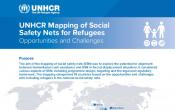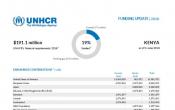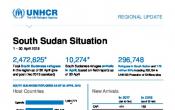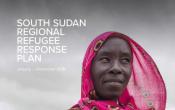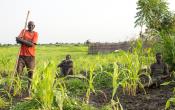Kenya
Operation: Kenya
Location
{"longitude":38,"latitude":0,"zoom_level":0,"iso_codes":"'KEN'"}
By clicking on the icons on the map, additional information is displayed.
Key Figures
| 2017 year-end results | |
| 134,670 | children enrolled in primary school |
| 35,410 | Somali refugees were assisted to return home |
| 3,920 | refugees successfully resettled |
| 1,500 | previously stateless Makonde recognized and registered as Kenyan citizens |
| 4,810 | individuals supported with entrepreneurship/business skills training |
| 2018 planning figures | |
| 165,700 | children will be enrolled in primary education |
| 65,400 | people will receive voluntary repatriation packages |
| 10,600 | best interests assessments (BIA) for child protection will be conducted |
| 1,850 | people will receive cash or vouchers for business start-up |
Latest Updates and Related Links
People of Concern
16%
Decrease in
2016
2016
| 2016 | 514,867 |
| 2015 | 615,112 |
| 2014 | 605,364 |

[["Refugees",451099],["Asylum-seekers",43764],["Returned refugees",4],["Stateless",20000]]
Loading ...
Kenya
< Back
2017
{"categories":[2013,2014,2015,2016,2017,2018],"budget":[251.58716732,285.14035843,251.196113504,269.17496251,230.288342676,191.06337188],"expenditure":[100.5735908,113.90905448,101.0363817,124.33198299,121.04733519,null]}
{"categories":[2013,2014,2015,2016,2017,2018],"p1":[251.37716724,284.77004236,250.824697504,268.67496278,229.378158795,190.58187567],"p2":[0.11000003,0.37031607,0.371416,0.49999973,0.910183881,0.48149621],"p3":[null,null,null,null,null,null],"p4":[0.10000005,null,null,null,null,null]}
{"categories":[2013,2014,2015,2016,2017,2018],"p1":[100.5735908,113.73583734,100.84664123,124.06368063,120.55286739,null],"p2":[null,0.17321714,0.18974047,0.26830236,0.4944678,null],"p3":[null,null,null,null,null,null],"p4":[null,null,null,null,null,null]}
Loading ...
CHOOSE A YEAR
- 2014
- 2015
- 2016
- 2017
- 2018
Operational context
The Government of Kenya has taken a number of positive actions to strengthen the protection of, and solutions for, refugees in Kenya and in the wider region. In March 2017, Kenya hosted the first Special Summit of the Intergovernmental Authority on Development (IGAD) dedicated to Somali refugees and returnees. The outcome- The Nairobi Declaration on Durable Solutions for Somali Refugees and Reintegration of Returnees in Somalia and its comprehensive Action Plan- marked a milestone in the application of the New York Declaration and its comprehensive refugee response framework (CRRF) at the regional level. The collective commitments by IGAD Member States had the effect of easing the pressure to close Dadaab camps.A second significant milestone in 2017 was Kenya’s declared commitment to roll-out the CRRF framework. The official announcement marked another clear signal that the protection and solutions environment in the country were steering towards comprehensive solutions.
A third significant operational result was the achievement of a durable solution and national recognition by nearly 1,500 members of the Makonde community-a previously stateless and unrecognized community.
The reduced resettlement quota by the United States of America led to a significant loss of resettlement places and valuable space for durable solutions. Remaining resettlement countries maintained relatively small quotas and restrictive criteria on nationalities and profiles of refugees to adequately compensate the loss.
Population trends
At the end of 2017, the total number of assisted refugees and asylum-seekers stood at more than 488,000. Kenya registered over 37,000 new arrivals, of which the majority, some 20,000, were from South Sudan. More than 35,000 returned to Somalia, while some 3,900 departed for resettlement. Also the stateless population dropped from an estimated 20,000 by the end of 2016 to 18,500 at the end of 2017.The three largest population groups in Kenya were from Somalia (284,300), South Sudan (111,600) and the Democratic Republic of Congo (35,700).
Key achievements
- Supported by the Kenyan government’s declared application of a comprehensive solutions approach (CRRF), the County governments of Garissa and Turkana together with UNHCR collaborated to ensure the inclusion of refugee-hosting areas in the next County Integrated Development Plans (CIDP).
- Enhanced UNHCR collaboration with national and international development and financial institutions contributed to Kenya successfully accessing the World Bank’s Development Response to Displacement Impacts Project (DRDIP), aimed at interventions to enhance socio-economic inclusion of both hosts and refugees.
- In Kakuma, oversight, anti-fraud and corruption systems were strengthened through introduction of innovative solutions empowering both population and service providers to reduce risks and ensure the highest standards of integrity, protection and service delivery.
Unmet needs
- Significant investments required to expand opportunities, particularly for the youth, in livelihoods, apprenticeships, secondary and tertiary education.
- A significant shortfall in capital investments and operating expenditures in Kalobeyei- the inclusive community model to showcase comprehensive solutions (CRRF) in Kenya- led to local tensions as the host community questions the international community’s ability to deliver on its commitments to the people and Government of Kenya.
Working environment
Kenya is generously hosting over 500,000 refugees and asylum-seekers, the majority from Somalia and South Sudan.In cooperation with the Government of Kenya, and supported by humanitarian and development partners, UNHCR will work to ensure access to asylum as well as a conducive protection and solutions environment; including maintenance of the civilian and humanitarian character of refugee-hosting areas. In addition, UNHCR will promote long-term development opportunities by supporting initiatives for peaceful coexistence and socio-economic integration among refugee and host communities. To this end, UNHCR will partner with the Government, development actors and private sector to support implementation of area-based development programmes, notably, the 2013-2017 Turkana County Integrated Development Plan, which includes the new Kalobeyei settlement.
Key priorities
In 2017, UNHCR’s operation will focus on:• Enabling area-based, socio-economic integration solutions in Kalobeyei’s refugee and host communities.
• Supporting voluntary repatriation to Somalia through tripartite mechanisms in partnership with the Governments of Kenya and Somalia and the support of the international community.
• Advocating for more resettlement opportunities in third countries, in a spirit of responsibility-sharing.
